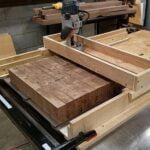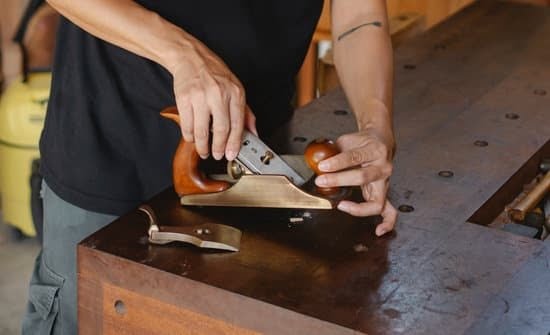Biscuit joinery, a technique frequently used in woodworking, is often praised for its ease and efficiency in creating strong joints. However, there are lingering questions about the fragility of biscuit joinery and its durability over time. In this article, we will delve into the delicate nature of biscuit joinery and address common misconceptions surrounding its strength.
Understanding the intricacies of biscuit joinery is essential to fully appreciate its potential weaknesses. This article will provide a brief overview of the technique, explaining how biscuits, small oval-shaped pieces of compressed wood, are inserted into slots cut into two corresponding pieces of wood to create a joint. By examining the mechanics behind this popular woodworking method, we can better understand why concerns about fragility arise.
Debunking common misconceptions surrounding biscuit joinery’s strength is another crucial aspect that will be explored in this article. Many believe that biscuits alone provide sufficient stability for joints and disregard other factors that may influence their strength. By addressing these misconceptions head-on, readers can gain a more accurate understanding of the capabilities and limitations of biscuit joinery in woodworking projects.
Understanding Biscuit Joinery
Biscuit joinery is a popular technique used in woodworking to create strong and seamless joints. Understanding the basics of this technique is essential for anyone looking to delve into woodworking or improve their skills. To provide a comprehensive overview, this section will cover the purpose of biscuit joinery, the tools required, and the step-by-step process involved.
The primary purpose of biscuit joinery is to create a strong bond between two pieces of wood without compromising aesthetics. By using specially designed football-shaped wooden biscuits coated with glue, woodworkers can align and connect multiple pieces of wood together. This technique allows for the creation of tight joints that are resistant to warping and movement over time.
To achieve successful biscuit joinery, a few key tools are necessary. First, a biscuit joiner (also known as a plate joiner) is used to cut matching slots in each piece of wood being joined. The size of the slot is determined by the size of the chosen biscuit. Additionally, clamps are essential for holding the pieces firmly together as the glue dries.
The step-by-step process for biscuit joinery involves several stages. First, measurements and markings are made on each piece of wood to indicate where the slots will be cut. Then, using the biscuit joiner, slots are cut into both pieces according to these markings. Next, glue is applied to both sides of each slot before inserting biscuits into one side. Finally, the pieces are carefully aligned and clamped together until the glue dries.
Understanding these basic principles and steps involved in biscuit joinery lays a solid foundation for further exploration of this woodworking technique. With practice and experience, woodworkers can master this method and create strong, durable joints that enhance their projects.
Useful Data
| Tool | Description |
|---|---|
| Biscuit Joiner | A power tool used to cut matching slots in wood for biscuit joinery. |
| Clamps | Used to hold the joined pieces of wood together while the glue dries. |
| Biscuits | Football-shaped wooden pieces coated with glue that are inserted into the slots and serve as reinforcement in the joint. |
The Strength of Biscuit Joinery
Biscuit Joinery as a Weak Joint
One common misconception about biscuit joinery is that it is not a strong joint. Some woodworkers may view biscuits as weak and unreliable, especially when compared to traditional woodworking joints such as mortise and tenon or dovetail joints. However, it is important to debunk this misconception and understand the true strength of biscuit joinery.
Forces Acting on Biscuit Joints
Biscuit joinery relies on the strength of the glue used to bond the biscuits to the wood pieces. When properly executed, biscuit joints can withstand significant forces and demonstrate excellent durability. The biscuits effectively distribute the load between the two wood pieces, creating a larger gluing surface area. This enhances the overall strength of the joint.
It is also crucial to consider that most woodworking projects do not face extreme forces that would challenge the strength of biscuit joints. In typical furniture or cabinetry applications, where biscuit joinery is commonly used, the joints are more than capable of handling normal everyday use without any issues.
Proper Execution for Strong Biscuit Joints
To ensure strong biscuit joints, proper execution is key. It is essential to follow best practices such as accurately aligning and clamping the wood pieces during assembly, ensuring a tight fit between the biscuits and slots, and using high-quality woodworking glue suitable for your project.
Additionally, other reinforcing techniques can be employed in conjunction with biscuit joinery if extra strength is desired for specific applications. These can include methods such as adding dowels or screws alongside biscuits to further secure the joint.
By understanding that properly executed biscuit joinery can provide robust connections in woodworking projects, woodworkers can confidently utilize this technique in their craft without concern for its inherent strength.
Factors Affecting Biscuit Joinery Fragility
When it comes to ensuring the durability of biscuit joinery in woodworking, two key factors play a significant role: moisture content and wood type. Understanding how these factors affect the fragility of biscuit joints is crucial for achieving long-lasting and sturdy woodworking projects.
One of the primary concerns when using biscuit joinery is the moisture content of the wood. This factor greatly influences the integrity and stability of the joint. If the wood has a high moisture content, it can result in shrinking or expansion as it dries or absorbs moisture from its surroundings.
This movement can potentially weaken and disrupt biscuit joints, leading to structural instability over time. On the other hand, if the wood is too dry, it may not be able to hold onto the biscuit effectively, resulting in a weak joint. It is recommended to use wood with an appropriate moisture content (around 6-8%) to achieve optimal results with biscuit joinery.
Another important factor affecting biscuit joinery fragility is the type of wood used. Different species of wood possess varying characteristics that influence their strength and stability. Some woods are naturally more prone to cracking or splitting, while others have greater resistance to external stressors.
For example, hardwoods like oak or maple are known for their durability and ability to withstand forces better than softwoods like pine or cedar. Understanding these unique qualities allows woodworkers to make informed decisions when selecting materials for their projects and ensures stronger biscuit joints overall.
Considering both moisture content and wood type when using biscuit joinery is essential for creating long-lasting and durable woodworking projects. By carefully controlling these factors during construction, woodworkers can mitigate potential weaknesses in their joints and enhance overall structural integrity.
Now that we have explored how moisture content and wood type can affect biscuit joinery fragility let us move on to Section 5: Assessing the Durability: Stress Test Results on Different Wood Species.
Assessing the Durability
To truly understand the durability of biscuit joinery, it is important to assess how different wood species hold up under stress. By subjecting various wood types to rigorous stress tests, woodworkers can gain valuable insights into the strength and longevity of biscuit joints.
Several factors are taken into consideration when conducting these tests, including the type of wood used and its moisture content. It is widely known that different wood species have varying levels of natural strength and hardness. For instance, hardwoods such as oak and maple are typically stronger than softwoods like pine or cedar.
This is due to differences in their cellular structure and density. Moisture content also plays a significant role in determining the overall strength of biscuit joints, as excessive moisture can compromise the joint’s integrity.
In a series of stress tests conducted by woodworking experts, various wood species were evaluated for their durability when used in conjunction with biscuit joinery. The tests involved subjecting the joints to heavy loads and measuring their resistance to deformation or failure. The results showed that while some wood species performed admirably under stress, others proved to be less durable.
Here are some key findings from the stress tests:
- Hardwoods like oak and maple demonstrated exceptional strength and durability when used in biscuit joinery. These woods exhibited minimal deformation and showed no signs of failure even under significant pressure.
- Softwoods like pine and cedar displayed lower levels of durability compared to hardwoods. These woods tended to deform more easily under stress, indicating that they may not be suitable for applications requiring high load-bearing capabilities.
- Excessive moisture content significantly reduced the overall strength of biscuit joints across all wood species tested. Joints made with moist or wet wood were more prone to failure or deformation compared to those made with properly dried lumber.
Based on these test results, it is clear that choosing the right wood species is crucial for achieving durable biscuit joints. Hardwoods with low moisture content are generally the best choice for applications that require strong and long-lasting connections. Additionally, proper wood selection and thorough moisture management can greatly increase the durability of biscuit joinery in woodworking projects.
Practical Tips for Strengthening Biscuit Joinery
Choosing the Right Glue
When it comes to strengthening biscuit joinery, selecting the appropriate glue is crucial. The glue acts as the bonding agent between the biscuits and the wood, ensuring a secure joint. For optimal strength, it is recommended to use a high-quality woodworking glue that dries clear and has a long open time. This allows for sufficient working time while also providing a strong bond.
One popular choice among woodworkers is polyvinyl acetate (PVA) glue, also known as carpenter’s glue. PVA glue is easy to work with and provides excellent adhesion. Additionally, it has good resistance to moisture, which is beneficial in preventing joint failure due to humidity or changes in environmental conditions.
Another option is epoxy resin glue, which offers superior strength and durability compared to PVA glue. Epoxy provides excellent resistance to both moisture and heat, making it ideal for projects exposed to harsh environments or high-stress situations. However, epoxy can be more challenging to work with due to its quick drying time and limited open time.
Applying the Glue
Proper application of glue is just as important as selecting the right type of adhesive. Ensure that both the biscuit slots and biscuits themselves are free from any dust or debris before applying the glue. This can be done by using an air compressor or a brush.
It is recommended to apply an even layer of glue on both sides of each biscuit slot using a small brush or roller applicator. This ensures that there is sufficient adhesive coverage for maximum bonding strength. Remember not to overload the slot with excess glue as this can lead to squeeze-out and affect the appearance of your project.
Once you have applied the glue, insert each biscuit into its corresponding slot immediately while the adhesive is still wet. Apply gentle pressure on all joints using clamps to ensure a tight fit and proper bonding. Wipe off any excess glue that may seep out of the joints using a damp cloth or sponge before it dries.
By selecting the right type of glue and properly applying it, you can significantly strengthen your biscuit joinery and improve the overall durability of your woodworking projects.
Avoiding Common Pitfalls
During the process of biscuit joinery, there are several common pitfalls that woodworkers should be aware of in order to achieve successful and durable joints. By avoiding these mistakes, craftsmen can ensure that their biscuit joinery remains sturdy and long-lasting.
One common pitfall to watch out for is using the wrong size biscuits. It is essential to select biscuits that match the thickness of the wood being joined. Using biscuits that are too small will result in weak joints, while using biscuits that are too large can cause the wood to split. Woodworkers should carefully measure the thickness of their material and choose biscuits accordingly.
Another mistake to avoid is improper alignment of the biscuits. When inserting biscuits into slots, it is crucial to ensure that they are properly aligned with each other and with the joining pieces of wood. Failure to do so can lead to misaligned joints and weak connections. Woodworkers should take their time and use accurate measuring tools or jigs to achieve precise alignment.
Additionally, inadequate glue application can compromise the strength of biscuit joints. It is important to apply a sufficient amount of glue evenly on both sides of each biscuit slot. This ensures that there is enough adhesive for a strong bond between the biscuit and the wood surfaces. Woodworkers should also avoid applying too much glue, as this may cause excess squeeze-out and make it difficult to clean up afterward.
To summarize, avoiding common pitfalls during biscuit joinery involves selecting appropriate-sized biscuits, ensuring proper alignment, and applying an adequate amount of glue. By paying attention to these details, woodworkers can create strong and durable biscuit joints in their woodworking projects.
Reinforcement Techniques for Fragile Biscuit Joints
Biscuit joinery is known for its strength and durability when used correctly. However, in certain cases where additional reinforcement is needed, woodworkers have the option to strengthen their biscuit joints using dowels or screws. These reinforcement techniques can be particularly useful when working with fragile wood types or in situations where extra stability is required.
One popular method of reinforcing biscuit joints is by using dowels. Dowels are cylindrical rods that are inserted into pre-drilled holes in the wooden pieces being joined together. When combined with biscuits, dowels provide additional structural support and help prevent joint failure, especially in applications where there will be a lot of stress or movement.
Another common technique for reinforcing biscuit joints is through the use of screws. Similar to dowels, screws are inserted through pre-drilled holes in the wood pieces. Unlike dowels, screws provide a higher level of mechanical strength due to their threading and ability to securely hold the two pieces of wood together.
When deciding between dowels or screws as reinforcement techniques for biscuit joints, it is important to consider factors such as the type of wood being used, the intended function of the joint, and personal preference. Dowels tend to be more visually appealing as they can be hidden within the joint, while screws may be more noticeable. Additionally, screws may require more precision in drilling and alignment compared to dowels.
| Consideration | Dowels | Screws |
|---|---|---|
| Strength | Provide additional support when combined with biscuits. | Offer a higher level of mechanical strength due to threading. |
| Aesthetics | Can be hidden within the joint, resulting in a cleaner appearance. | More noticeable, may require additional finishing techniques to hide the screws. |
| Installation | Relatively simple process of drilling and inserting dowels. | Require more precision in drilling and alignment. |
When reinforcing biscuit joints with dowels or screws, it is essential to follow proper woodworking techniques to ensure a strong and durable joint. This includes careful measurement, precise drilling, and using appropriate adhesives or wood glue.
Alternative Joinery Methods
Biscuit joinery is a popular technique in woodworking for its simplicity and versatility. However, it is important to recognize that there are other joinery methods available that may be better suited for certain projects or materials. In this section, we will explore some alternative joinery methods and compare them to biscuit joinery.
One alternative method commonly used in woodworking is the use of dovetail joints. Dovetail joints have been utilized for centuries and are known for their strength and durability. These joints consist of interlocking angled edges that provide stability and prevent the pieces from pulling apart. While biscuit joinery excels at aligning and reinforcing pieces, dovetail joints offer exceptional strength and are often used in furniture construction where extra support is needed.
Another popular alternative to biscuit joinery is the use of mortise and tenon joints. This traditional method involves carving out a cavity (mortise) in one piece of wood and creating a protruding tongue (tenon) on another piece. The tenon fits snugly into the mortise, creating a strong bond. Mortise and tenon joints are known for their resilience under heavy loads, making them ideal for furniture with substantial weight-bearing requirements.
In contrast to biscuit joinery’s emphasis on alignment and ease of assembly, pocket hole joinery focuses on speed and efficiency. Pocket holes involve drilling an angled hole into one piece of wood to create a pocket, which then receives a screw or dowel to anchor it to another piece of wood.
This method is particularly useful when joining boards at 90-degree angles or constructing frames quickly. While pocket hole joinery does not offer the same level of strength as some other techniques, it can still be effective in many situations where aesthetics or time savings are prioritized over maximum durability.
Each alternative joinery method has its own advantages and considerations. The choice between biscuit joinery and these alternatives ultimately depends on the specific project, materials, and desired outcome. By understanding the differences between these techniques, woodworkers can make informed decisions on which method will best suit their needs and ensure durable woodworking projects.
Conclusion
In conclusion, the fragility of biscuit joinery in woodworking is a topic that requires careful consideration and understanding. While biscuit joinery can be delicate, it is important to note that with the right techniques and knowledge, durable biscuit joints can be achieved.
Throughout this article, we explored the intricacies of biscuit joinery, debunked common misconceptions about its strength, and discussed factors that affect its fragility such as moisture content and wood type. We also assessed the durability of biscuit joints through stress test results on different wood species.
To strengthen biscuit joinery, selecting the right glue and applying it correctly is crucial. Additionally, we highlighted common pitfalls to avoid during biscuit joinery and provided reinforcement techniques such as using dowels or screws to reinforce fragile joints.
It is also important to note that while biscuit joinery is a popular technique in woodworking, there are alternative joinery methods available. By better understanding the strengths and weaknesses of different techniques, woodworkers can make informed decisions on which method best suits their project’s needs.
Frequently Asked Questions
How strong are wood biscuits?
Wood biscuits are considered to be relatively strong, although their strength ultimately depends on a few factors. Biscuits are typically made from compressed wood, such as beech or maple, which gives them good inherent strength.
When used properly, wood biscuits can provide a strong joining method for woodworking projects. However, it is important to note that the strength of a biscuit joint also relies on the quality of the glue used and the overall design and construction of the joint.
Are biscuits stronger than dowels?
Comparing biscuits and dowels in terms of strength can be somewhat subjective depending on various factors. Dowels, which are cylindrical pegs often made from solid wood or metal, have been used for centuries in woodworking and are known for their structural integrity and strength.
While biscuits can provide sufficient strength for many applications, dowel joints are generally considered to be stronger due to their larger surface area and greater potential for gluing surface contact. However, both biscuits and dowels have their own advantages depending on the specific project requirements.
Are biscuits strong enough for cabinets?
Whether or not biscuits are strong enough for cabinets largely depends on several factors including cabinet design, size, weight load, and material choice. Biscuit joints can provide adequate strength for most cabinet constructions when used appropriately in conjunction with other joinery methods like glue and screws or nails. The usage of additional reinforcing elements such as corner blocks or bracing can further enhance the overall strength of biscuit joints in cabinets.
It is crucial to consider all these factors along with understanding the limitations of biscuit joints when determining if they will provide the required strength for a particular cabinet project. Ultimately, it may be advisable to consult with an experienced woodworker or carpenter who can assess your specific cabinet plans before deciding definitively on biscuit joinery as it pertains to structural integrity and longevity.

Hi everyone! I’m a woodworker and blogger, and this is my woodworking blog. In my blog, I share tips and tricks for woodworkers of all skill levels, as well as project ideas that you can try yourself.





